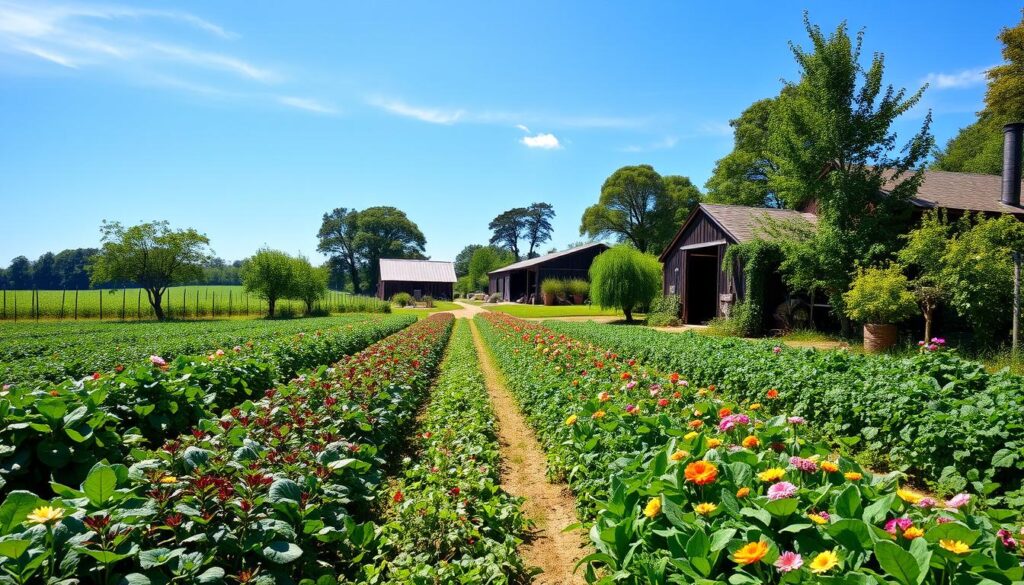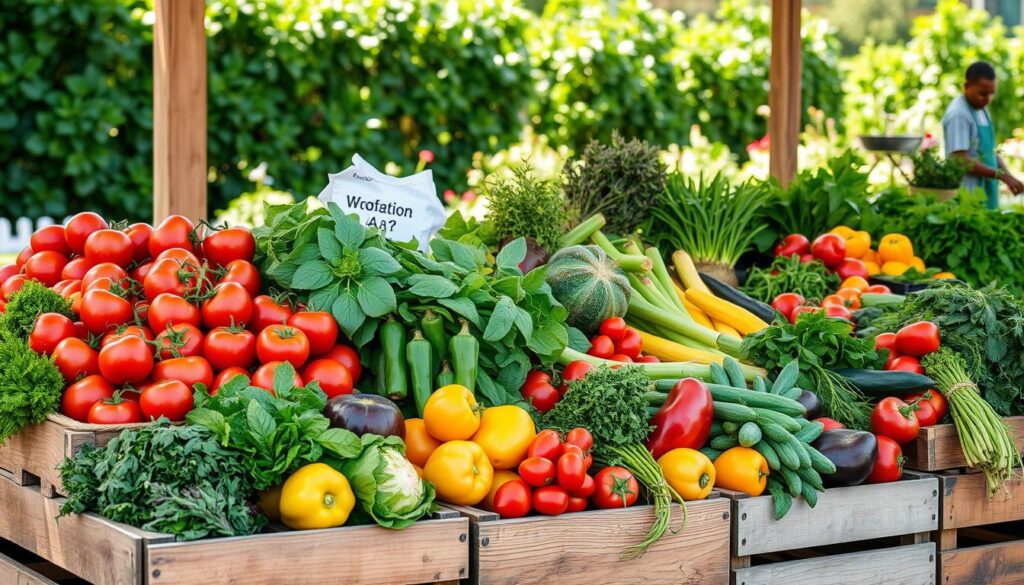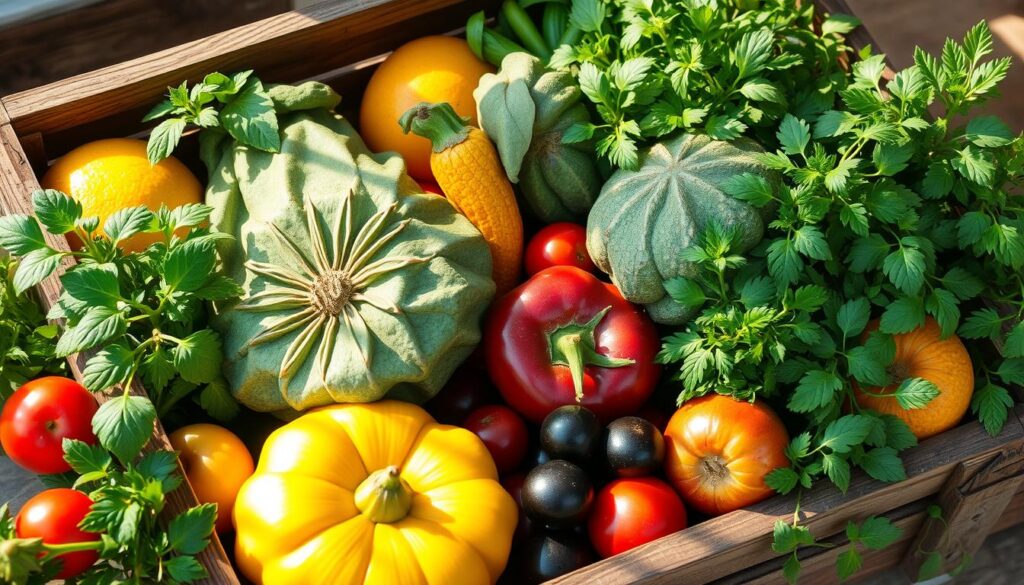Ever wondered what “organic” really means for food? Or if organic products are truly better for you and the planet? This guide explores the world of organic food. We’ll look at what makes it special, its health benefits, and how to choose the best for your body.
Key Takeaways
- Understand the USDA’s strict organic certification standards and common organic labels
- Discover the impressive health advantages of choosing organic foods
- Learn effective strategies for smart, budget-friendly organic shopping
- Explore the environmental impact of organic farming practices
- Differentiate between local and organic produce to make the best choices
Understanding What Makes Food Truly Organic
The term “organic” is a beacon of hope for health-conscious consumers. But what does it really mean? How can we know if we’re choosing the right food? Let’s explore organic certification, label meanings, and the organic production process.
USDA Organic Certification Standards
The United States Department of Agriculture (USDA) sets strict guidelines for organic farming and processing. To get the USDA Organic seal, producers must follow strict rules. These rules ban synthetic pesticides, fertilizers, and genetically modified organisms (non-GMO). This makes sure organic food is grown and handled in an eco-friendly way.
Common Organic Labels and Their Meanings
- 100% Organic”: The product is made entirely with certified organic ingredients.
- “Organic”: At least 95% of the product’s ingredients are certified organic.
- “Made with Organic Ingredients”: At least 70% of the product’s ingredients are certified organic.
The Organic Production Process
Organic farming focuses on sustainable agriculture practices. It protects the environment and human health. Organic farming uses natural pest control, promotes soil health, and avoids synthetic chemicals. This leads to a diverse, resilient ecosystem that produces non-GMO foods without harming the planet.

“Organic agriculture is an ecological production management system that promotes and enhances biodiversity, biological cycles, and soil biological activity. It is based on minimal use of off-farm inputs and on management practices that restore, maintain, or enhance ecological harmony.” – USDA
Understanding USDA organic standards, label claims, and organic production helps us make better choices. These choices support sustainable agriculture and our health.
The Health Benefits of Choosing Organic Foods
Our health is greatly influenced by what we eat. Organic foods offer a big advantage. They are pesticide-free, whole, and natural, providing many health benefits.
Organic foods have less pesticide exposure. Conventional farming uses many chemicals, which can harm us. Organic farming uses fewer toxins, letting us enjoy nature’s pure flavors.
- Reduced pesticide exposure
- Higher nutrient content
- Enhanced antioxidant levels
- Better gut health
- Lower risk of certain diseases
Organic foods also have more vitamins, minerals, and antioxidants. This means we get more good stuff in our bodies. We avoid harmful chemicals and get more nutrients.
Eating organic foods can help support a healthy gut microbiome, which is crucial for overall well-being. The absence of synthetic additives and preservatives in organic products can create a more balanced ecosystem in our digestive system.
Research shows organic foods can lower the risk of diseases like cancer and heart disease. This is because they have fewer harmful substances.
Switching to organic foods can greatly improve your health. It’s good for you and the planet too.

Organic Food: Essential Guidelines for Smart Shopping
Shopping for organic food can seem tough, but don’t worry! We’re here to help you become a smart organic shopper. We’ll guide you through reading labels and using new tech. You’ll be all set.
Reading Organic Labels Effectively
Organic labels can be confusing, but you can learn to read them easily. Look for the USDA Organic seal. It means the product is made with local sourcing and ethical consumption in mind. Also, watch for “100% Organic,” “Organic,” and “Made with Organic Ingredients” labels.
Using Food Scan Genius for Quick Verification
Today, there’s an app for everything, including organic shopping. The Food Scan Genius app lets you scan barcodes for quick info on organic products. It’s perfect for those who love farm-to-table food and want to make smart choices.
Seasonal Shopping Tips
- Buy organic produce when it’s in season. It’s cheaper and more nutritious.
- Visit farmer’s markets and local sourcing spots. You’ll get fresh, tasty organic food and meet the farmers.
- Plan meals with seasonal produce. It saves money and helps the environment by reducing transport needs.
With these tips, you’ll be ready to shop for the best organic foods. Enjoy your healthy, farm-to-table shopping adventures!
Common Misconceptions About Organic Products
Organic food is getting more popular, but many people still have wrong ideas about it. Let’s look at some common myths and clear them up.
Many think organic food is always pricier. While it’s true that organic items might cost a bit more, the difference isn’t as big as you might think. With smart shopping, you can find affordable organic choices that fit any budget.
Some believe organic farming isn’t as productive as traditional farming. But, modern non-GMO and sustainable agriculture methods in organic farming can be just as good, if not better. Organic farms also use eco-friendly farming practices that are better for the environment.
Others think organic food doesn’t taste as good as regular produce. But, many organic fans say it tastes richer and more vibrant. This is because organic food doesn’t have artificial preservatives and is grown naturally.
“Organic food is nothing more than a fad. It doesn’t offer any real benefits over regular food.”
This statement is not true. Studies show organic foods have more vitamins, minerals, and antioxidants than non-organic foods. Choosing organic is a smart choice for your health and well-being.
By clearing up these myths, we can encourage more people to try organic products. It’s a simple way to care for your health and the planet.
| Myth | Fact |
|---|---|
| Organic food is always more expensive | Organic options can be found at various price points |
| Organic farming is less productive | Modern organic techniques can yield comparable or better results |
| Organic food doesn’t taste as good | Organic produce often has a richer, more vibrant flavor |
| Organic food is just a fad | Organic products offer proven health and environmental benefits |
The Environmental Impact of Organic Farming
Organic farming is all about sustainable agriculture. It has a huge positive impact on our environment. Organic farmers use eco-friendly methods to protect our natural resources and help our planet stay healthy.
Soil Conservation Methods
Organic farming focuses on keeping the soil healthy. They use crop rotation, cover cropping, and natural fertilizers. This keeps the soil fertile and prevents erosion.
It also helps plants grow strong and absorbs carbon. This makes organic farming a key player in fighting climate change.
Water Management Practices
Water is very important, and organic farmers know it. They use efficient irrigation and save water. This reduces their water use and protects local water sources.
Biodiversity Benefits
Organic farming is great for biodiversity. It avoids synthetic pesticides and uses natural pest control. This creates a home for many different animals and insects.
Choosing organic supports our health and the environment. The organic movement is about sustainable agriculture, eco-friendly farming, and making ethical choices. These choices have a big positive effect on our planet. Let’s keep celebrating the good things about organic farming and make choices that help our future.
Organic farming is not only good for our health, but it’s also essential for the health of our planet. By embracing sustainable practices, we can create a brighter, more sustainable future for generations to come.”
Making the Transition to Organic Eating
Starting a whole foods, natural produce, farm-to-table lifestyle might seem hard. But we’re here to help make it easy. Just follow a few simple steps, and you’ll be on your way to eating the best nature has to offer.
Start by making small changes. Swap one or two non-organic items for organic ones each week. This way, your taste buds and budget can adjust slowly. Every organic fruit, veggie, and whole grain you add helps.
- Begin with the “Dirty Dozen” – items with high pesticide residues. Choose organic versions to reduce exposure.
- Check out local farmer’s markets or join a Community Supported Agriculture (CSA) program. They offer fresh, tasty organic produce.
- Fill your pantry with organic basics like whole grains, nuts, seeds, and legumes. These are key for a healthy diet.
Once you’re more confident, take bigger steps. Switch to organic dairy, eggs, and meat as you can. Enjoy the rich flavors and health benefits of whole foods, natural produce, and farm-to-table foods.
Eating organic is not just a dietary choice – it’s a lifestyle that connects us to the earth and nourishes our bodies and souls.
The path to organic eating is yours to follow. Celebrate every small win and savor the tasty, healthy foods you’ll discover. Your body and the planet will appreciate it.
Price Comparison: Organic vs. Conventional Foods
Shopping for groceries can be tricky, especially when comparing organic and conventional foods. But, with some smart choices, we can enjoy local sourcing, ethical consumption, and sustainable agriculture without spending too much.
Budget-Friendly Organic Shopping Strategies
Organic food doesn’t have to be expensive. Here are some tips to help you save money:
- Choose in-season produce, which is usually cheaper than out-of-season options.
- Buy in bulk for items like grains, nuts, and dried fruits.
- Look for store-brand organic products, which are often less expensive than name-brand ones.
- Visit local farmer’s markets or join a CSA program for fresh, locally sourced organic produce at good prices.
Most Cost-Effective Organic Purchases
Not all organic foods are the same when it comes to price. Here are some affordable organic items to consider:
| Product | Organic Price | Conventional Price | Price Difference |
|---|---|---|---|
| Eggs | $4.99/dozen | $3.99/dozen | $1.00 |
| Bananas | $0.79/lb | $0.59/lb | $0.20 |
| Spinach | $3.99/bunch | $2.99/bunch | $1.00 |
| Oats | $4.99/lb | $3.99/lb | $1.00 |
By choosing these affordable organic options, you can enjoy the perks of ethical consumption and sustainable agriculture without overspending.
Best Organic Food Storage Practices
Buying organic produce is a great step towards a healthier, more sustainable lifestyle. But once you’ve stocked up, the real challenge begins. Properly storing them is key to keeping their freshness and nutritional value. Don’t worry, we’ve got you covered with expert tips to enjoy your farm-to-table bounty.
Maximize Fridge Space Efficiently
Organizing organic fruits and veggies is crucial. Use reusable storage containers, crisper drawers, and door shelves. This keeps your whole foods neat and easy to find. It also prevents them from getting lost and spoiled.
Master the Art of Produce Preservation
- Wrap leafy greens in damp paper towels to maintain crispness.
- Store berries and other delicate fruits in shallow containers lined with paper towels to absorb excess moisture.
- For root vegetables like carrots and beets, trim the greens and store them in the crisper drawer.
- Hang bananas, tomatoes, and avocados outside the fridge to ripen at room temperature.
Freeze for Future Enjoyment
Don’t let your organic bounty go to waste! Freezing produce is a great way to extend its shelf life. Blanch and flash-freeze items like berries, herbs, and chopped vegetables. Then, store them in airtight containers or bags. This preserves their flavor, texture, and nutritional content for months.
| Organic Food Item | Optimal Storage Conditions | Shelf Life |
|---|---|---|
| Leafy Greens | Refrigerator, wrapped in damp paper towels | 3-5 days |
| Berries | Refrigerator, in shallow containers lined with paper towels | 3-5 days |
| Root Vegetables | Refrigerator, in crisper drawer with greens trimmed | 1-2 weeks |
| Bananas, Tomatoes, Avocados | Room temperature | 3-5 days |
| Frozen Produce | Freezer, in airtight containers or bags | 6-12 months |
By following these best organic food storage practices, you’ll keep your produce fresh and flavorful. Enjoy the bounty of your organic purchases to the fullest!
Local vs. Organic: Understanding the Difference
Choosing between local and organic food can be confusing. But, you don’t have to pick just one. Supporting local organic farmers is a great way to feed your body and help your community. Let’s look at why this combo is so good.
Benefits of Supporting Local Organic Farmers
Choosing local organic produce cuts down on carbon emissions. It also helps your community’s health and the environment. Local farmers use green methods that make soil better, save water, and help different species thrive.
You’ll also get food that’s fresher and tastes better because it’s grown nearby.
Community Supported Agriculture (CSA) Programs
CSA programs are a great way to connect with local farmers. They let you buy a share of a farm’s harvest. This means you get a steady supply of fresh, healthy food.
It also supports small farmers and promotes fair food systems. Joining a CSA makes you a more aware and involved consumer. It strengthens your local food community too.
FAQ
What is the USDA organic certification and what does it mean?
The USDA organic certification is a set of rules for “organic” food. Farms and producers must follow strict guidelines. These include soil quality, pest control, and no synthetic chemicals or fertilizers.
What are the common organic labels and what do they signify?
You’ll see labels like “USDA Organic,” “100% Organic,” “Organic,” and “Made with Organic Ingredients.” These labels show the organic content level. “USDA Organic” is the highest and most comprehensive.
What are the health benefits of choosing organic foods?
Organic foods have more nutrients like antioxidants and fewer pesticides. Studies show organic produce can have up to 69% more antioxidants. It also has up to 50% fewer nitrates than non-organic foods.
How can I effectively read and understand organic food labels?
Look for the USDA organic seal to ensure the product meets strict standards. Also, check the percentage of organic ingredients. Look for claims like “non-GMO” or “pesticide-free.”
What is the Food Scan Genius app and how can it help me verify organic products?
The Food Scan Genius app lets you scan barcodes to check if items are organic, non-GMO, and free of artificial ingredients. It’s a useful tool for making smart choices at the store.
What are some common misconceptions about organic products?
Some think organic foods are always more expensive. But prices vary by product. Another myth is that organic foods don’t taste as good. Many people find them more flavorful.
How do organic farming practices benefit the environment?
Organic farming conserves soil, manages water, and promotes biodiversity. It uses natural methods to enrich soil and protect ecosystems. This reduces greenhouse gas emissions and conserves resources, supporting a healthier environment.
What are some budget-friendly strategies for buying organic foods?
Focus on the “Dirty Dozen” produce items with high pesticide levels. Shop at farmers markets or join a CSA program. Stock up on affordable organic pantry staples like beans, grains, and spices.
How should I store organic produce to maximize freshness?
Store organic fruits and vegetables unwashed in the fridge. Use them within a few days for best nutrition and flavor. Avoid overcrowding and use reusable bags or containers to extend shelf life.
What are the key differences between local and organic food?
Local food is grown nearby, while organic food meets USDA standards. Buying from local organic farmers means fresher, more flavorful produce grown sustainably.





